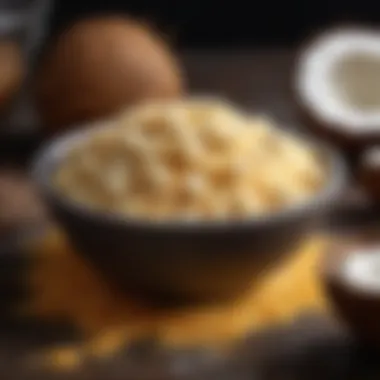Mastering Coconut Flour: Versatile Cooking Guide


Intro
Coconut flour has emerged as a staple in many modern kitchens due to its myriad applications and health benefits. For those looking to incorporate more nutrient-rich ingredients into dishes, this flour offers a wealth of opportunities to enhance culinary creations. Its unique properties make it ideal for gluten-free and lower-carb recipes, appealing to a wide-range of diets. This guide navigates the essential ways to include coconut flour in daily meals while also addressing adjustments for common baking practices.
Recipe Overview
- Creative Name: Coconut Flour Pancakes Delight
- Servings: 2
- Preparation Time: 10 minutes
- Cooking Time: 15 minutes
- Difficulty Level: Easy
- Key Ingredients:
- Coconut flour
- Eggs
- Almond milk
- Vanilla extract
- Baking powder
Coconut Flour Pancakes Delight harmoniously combines simplicity with health, transforming breakfast into a nourishing start to your day. With only a handful of ingredients, you're on your way to a tasty meal that respects both busy schedules and dietary requirements.
Step-by-Step Instructions
- Prep Ingredients:
- Combine Dry Ingredients:
- Cook the Pancakes:
- Measure 1/4 cup of coconut flour and place it in a mixing bowl.
- Crack two eggs into the bowl and whisk until well combined.
- Add 1/2 cup of almond milk and a teaspoon of vanilla extract.
- Incorporate one teaspoon of baking powder for fluffiness.
- If using additional sweeteners or spices, add them to the dry mixture, combining well.
- Heat a skillet over medium heat and add a small amount of oil to prevent sticking.
- Pour a ladle of the pancake batter into the skillet, formatting it to your preferred size.
- Cook for about 2-3 minutes, or until bubbles appear in the batter. Flip carefully.
- Cook for another 2 minutes on the other side.
Time-Saving Strategies
For quicker pancakes, pre-prepare the batter the night before and store it in the fridge for use in the morning. Replace almond milk with any milk substitute that suits your taste or diet, such as oat or soy milk.
Nutritional Information
- Calories per Portion: Approximately 250 kcal
- Protein: 10 grams
- Fats: 16 grams
- Carbohydrates: 22 grams
These pancakes indulge you with great protein and a balanced oil content along with sufficient carbs to help fuel your morning. Additionally, coconut flour is high in fiber, promoting digestive health, while the healthy fats from the coconut can support overall well-being.
Quick Cooking Tips
- Utilize a non-stick pan or an electric griddle for easier cooking of multiple pancakes at once.
- Multi-task by setting up your toppings—like fresh fruits or yogurt—while the pancakes are sizzling.
- If looking to branch out, an air fryer can also be a fast alternative that gives a unique twist to pancake preparation.
Related Recipes & Variations
- Consider pairing the pancakes with a tropical fruit salad for added flavor and nutrition.
- For a vegan option, substitute eggs with flax eggs by mixing one tablespoon of ground flaxseed with two tablespoons of water.
- Experiment with additional spices, such as cinnamon or nutmeg, to create unique flavor profiles.
Explore coconut flour beyond pancakes! This versatile ingredient can elevate dishes ranging from smoothies to savory treats.
Preface to Coconut Flour
Coconut flour emerges as a significant alternative in cooking, especially for those looking to incorporate nutritious elements into their meals. This article places a spotlight on coconut flour, delving into its uses, nutritional benefits, and practical applications. The aim is to enable readers to understand how coconut flour can fit seamlessly into a variety of cooking practices.
What is Coconut Flour?
Coconut flour is a product made from dried and ground meat of the coconut. When coconuts are processed for oil, the leftover flesh is dried and ground to produce this fine flour. This makes coconut flour rich in flavor while offering a unique texture. It provides options for those excluding gluten from their diet and contributes additional nutrients to meals.
Unlike regular flours made from wheat, coconut flour has distinct properties that set it apart. It is gluten-free, which makes it a staple for many baking needs. The natural taste is subtly sweet, making it suitable for both sweet and savory recipes.
Nutritional Profile
The nutritional profile of coconut flour showcases its health benefits. It is high in fiber while being low in carbohydrates, positioning it as an ideal choice for those managing blood sugar levels or looking to lose weight.


Some key nutritional elements found in coconut flour include:
- Dietary Fiber: Provides digestive health benefits and helps contribute to a feeling of fullness.
- Protein: Contains a decent amount of protein when compared to other grain flours.
- Fats: It has a small amount of natural fat since it is made from coconut meat, but these are mainly healthy saturated fats.
- Minerals: Offers beneficial minerals like manganese and copper, contributing to various bodily functions and promoting overall health.
Overall, incorporating coconut flour into your diet can lead to numerous health benefits. Careful understanding of its properties and uses will equip consumers with the tools to prepare balanced and nutritious meals.
Benefits of Using Coconut Flour
Coconut flour offers a range of benefits, making it a noteworthy ingredient in modern culinary practices. As the culinary landscape evolves, there is a growing need for versatile, healthy, and adaptable food options especially for those with specific dietary requirements. By understanding these benefits, readers can make informed decisions about adding coconut flour to their cooking repertoire.
Gluten-Free Alternative
For individuals who cannot consume gluten, coconut flour serves as an excellent substitute. Derived from dried coconut meat, this flour is naturally gluten-free, making it a safe choice for those with celiac disease or gluten sensitivities. The texture and flavor of coconut flour can work well in various baked goods, enhancing the dishes without compromising on taste.
When replacing wheat flour, it’s essential to note that coconut flour has distinct properties. It can absorb a significant amount of liquid, potentially resulting in dry textures if proportions are not adjusted. Additionally, combining it with other gluten-free flours can create more balanced outcomes. From cookies to bread, lovers of gluten-free options gain access to nutritive and delicious alternatives, simple pleasures without the unwanted side effects.
Rich in Fiber
Coconut flour contains a generous amount of dietary fiber, which plays a vital role in digestive health. Just a 1/4 cup of coconut flour boasts around 10 grams of fiber. This high fiber content promotes feelings of fullness, supports digestive regularity, and can aid in weight management. Moreover, fiber has benefits for heart health by helping lower cholesterol levels.
Adding coconut flour to recipes or meals is a practical option for increasing daily fiber intake. It can be incorporated into smoothies, mixed into batter for baked goods, or even used as a topping for different dishes. For those seeking a healthful lifestyle, this characteristic of coconut flour reinforces its status as an admirable choice in the kitchen.
Low Glycemic Index
Coconut flour has a low glycemic index compared to traditional flour options. This means it has a lesser impact on blood sugar levels when consumed. For individuals managing diabetes or those concerned with insulin sensitivity, it’s crucial to opt for food that can place minimal strain on glycemic control.
Foods that have lower glycemic indices are often better choices for sustained energy rather than abrupt spikes and drops in blood sugar. Coconut flour fits this description.
When used in cooking or baking, coconut flour can assist in maintaining energy levels throughout the day. This quality makes it particularly appealing to health-conscious individuals and those looking to adjust their diet for better metabolic outcomes.
Overall, the benefits of coconut flour align with the ideals of a contemporary, health-conscious approach to cooking. Its ability to cater to multiple dietary needs while being versatile in the kitchen ensures it can enhance meals for anyone.
Coconut Flour in Culinary Applications
Coconut flour has substantial applications in the culinary world. Its versatility extends beyond traditional baking into a broader range of cooking uses. This section emphasizes the significance of coconut flour in various recipes, helping you harness its unique properties effectively.
Baking with Coconut Flour
Baking with coconut flour requires some adjustments and understanding of its properties compared to wheat flour. It can lead to delightful flavors and textures when done correctly.
Tips for Substitution
Substituting coconut flour for wheat flour can be enlightening but needs care. The key characteristic of coconut flour is its high absorbency. This means you can’t simply replace one for one. A beneficial practice is to use about one-quarter to one-third as much coconut flour as a recipe calls for wheat flour. Because of its absorbent nature, it is significant to increase the liquid ingredients in the recipe to avoid a dry result. This sometimes results in moist baked goods that have an uplifting taste. Keep in mind that while it is easy to err on the side of using too much coconut flour, managing this ratio is crucial in achieving fine results.
Adjusting Liquids
Due to its high absorbency, adjusting liquids is vital when working with coconut flour. When using this flour, you generally need to add extra liquid compared to more traditional flours. A good approach is to balance out the liquid in proportion to how much coconut flour is used. This practice not only prevents dryness but also maintains the orderliness of batter or dough. Awareness of this adjustment unlocks the potential of scrumptious coconut flour recipes, allowing for enhanced flavor without the hassle of excess cohesion.
Common Recipes
Common recipes such as muffins, breads, and cookies highlight teh abilities of coconut flour. One significant charm in these baked items is not just the flavor but also the nutritional boost that coconut flour provides. It carries an inflicted sweetness and texture to baked goods that makes them enjoyable. Recipes frequently feature a basic combination of coconut flour, eggs, and liquid. These recipes might appear simple, but can lead to rows of delicious treats suitable for specifc dietary needs. Be conscious of the common pitfalls and partake in experimenting those variations to uncover delightful results.
Cooking with Coconut Flour
The culinary use of coconut flour goes beyond baking; it transforms cooking options as well, thouroughly enhancing the delightful taste while keeping nutrition high.
Thickening Soups and Sauces


Thickening soups and sauces with coconut flour is a practical approach. Instead of using cornstarch or other traditional thickeners. This ingredient offers a wholesome alternative and contributes fiber, which may contribute sustenance to your meals. The incorporation comes with an equal mixture of smoothness and a hit of coconut flavor. Being aware that adding too much might lead to clumping is critical.
Coating Meat and Fish
Coating meat and fish with coconut flour yields a unique crust. This method accentuating the crispy factor adds fragrance to your dishes. Coconut flour presents a gluten-free option that many individuals seek in batters, perfect for various dietary preferences. The unique feature is its nutritious property; it adds healthy fats. Be aware, comfort vegatarians may find the coconut flavor isn't harmonious to every dish.
Making Pancakes and Waffles
Making pancakes and waffles with coconut flour appropriately showcases its unique traits. Cocunut flour lends itself well to these batters, providing an odd texture and distinct flavor. You typically require eggs to bridge the components, as this holds them together. Keep in mind that some experiments lead to unexpected results, taking attention to the mixtures often leads to great dishes. Understnding measured steps can make this a star of breakfast or a quick snack without over complexity or time.
Through thoughtful mixture proportions, you can experiment and delight in the culinary places that coconut flour can take you.
This section effectively illustrates how to smoothly integrate coconut flour in various culinary applications. Armed with knowledge from this guide, you're on your way to excellence in the kitchen all with the delicious allure of coconut flour.
Adapting Recipes for Coconut Flour
Coconut flour can transform traditional recipes, but adjustments are essential to use it successfully. This section explores the importance of adapting recipes for coconut flour, highlighting key elements in this process. It offers insights into the unique properties of coconut flour that affect both the texture and taste of dishes. Understanding these properties helps in achieving the best possible outcomes.
Understanding the Absorption Properties
Coconut flour has an exceptional absorbsion capacity. It tends to soak up more liquid than other flours. This characteristic is crucial when adapting recipes. The high fiber content of coconut flour also contributes to this property. For example, if a recipe requires one cup of all-purpose flour, a good starting point is to use only one-third of a cup of coconut flour. Then, increase the liquid components by approximately double. This adjustment can prevent most baked items from becoming too dense or dry.
Recognizing the absorption properties also enables better melding of flavors. Recipes that utilize liquid ingredients, like eggs or dairy, can become richer when paired effectively with coconut flour. Furthermore, allowing the dough or batter to sit can increase moisture absorption, contributing to improved textures in the final product. Understanding these features is vital for successful cooking with this ingredient.
Experimenting with Ratios
Coconut flour is not a one-to-one substitute for traditional flour. It's essential to experiment with ratios when altering existing recipes. Finding the right balance is critical. Since coconut flour and traditional flour behave differently, one must find effective ratios to avoid frustrating results.
To begin experimenting, consider the following points:
- Baking Recipes: Start with a ratio of 1:3 for coconut flour to standard flour. This may vary based on the recipe complexity and desired texture.
- Thickness Variations: Adjust the size of your liquids when modifying a baking recipe. Increase moisture by approximately one egg per each 1/4-1/3 cup of coconut flour used.
- Trial and Error: It can take few attempts to perfect the ideal mix. Document results so you can learn from each bake.
This see-sawing between liquid quantity and dry flour is the key in experimenting with ratios. Being methodical in the adaption process allows for variation and personalization of culinary creations. Ultimately, gaining familiarity with coconut flour will enable individuals to craft delectable dishes perfectly suited to their tastes.
Challenges of Using Coconut Flour
Coconut flour presents itself as a promising ingredient, but its usage also brings challenges that deserve attention. Understanding these challenges is essential for anyone looking to incorporate coconut flour into their culinary routines effectively. This section will explore taste and texture differences, as well as the storage and shelf life of coconut flour.
Taste and Texture Differences
When using coconut flour, one of the most significant considerations is its distinct taste and texture. Unlike wheat flour, coconut flour carries a subtle sweetness and a noticeable coconut flavor. This flavor is enjoyable in many contexts but can alter the overall taste profile of dishes. Thus, a careful balance is necessary when integrating coconut flour with other ingredients.
Texture also presents unique challenges. Coconut flour absorbs liquid at a much higher rate than traditional flours. This property can lead to denser baked goods if the ratios of wet to dry ingredients are not properly adjusted. To ensure a more rounded texture, you may need to include additional moisture, such as eggs or other liquid ingredients. It is recommended to start by replacing only a small portion of flour in a recipe, gradually increasing as one becomes more comfortable with how coconut flour behaves.
Keep in mind: Experimentation is key when adapting recipes to include coconut flour. Ovewhelming taste or dense texture can be minimized with practice.
Storage and Shelf Life
Proper storage is vitale for maintaining the quality of coconut flour. It needs to be kept in a cool, dry environment. Ideally, you should store coconut flour in an airtight container to protect it from humidity, which can cause clumping or spoilage. Its natural oils can lead to rancidity if not stored correctly.
Coconut flour is generally shelf-stable for several months when kept in a pantry. However, once opened, it is better suited for longer-term storage in the refrigerator or the freezer. When stored this way, it can last up to a year or more. Always check the product for signs of spoilage, such as off smells or colored spots, before using.
Key Considerations
- Store in an airtight container
- Keep in a cool, dry place (or refrigerate for longer shelf life)
- Check for spoilage before use


Recognizing both the taste and texture differences, along with storage and shelf life issues, equips cooks with the knowledge needed for successful integration of coconut flour in their recipes. Embracing these challenges can lead to creative and enjoyable dishes suited for various dietary needs.
Coconut Flour Recipes for Busy Individuals
In the fast-paced world, finding time to prepare healthy meals can be challenging. Using coconut flour offers an efficient way to maintain nutrition without excessive time in the kitchen. Recipes designed for busy individuals maximize nutrition while being straightforward and quick to prepare. Coconut flour, with its unique properties, serves as an effective ingredient for various meals and snacks. Focusing on practical coconut flour recipes allows one to enjoy the benefits of healthier cooking with minimal effort.
Quick Breakfast Options
Pancakes
Coconut flour pancakes provide a nutritious start to a busy day. They are high in fiber and lower in carbohydrates compared to traditional pancakes. This helps to stabilize energy levels after breakfast, making it a great option for busy mornings. One notable aspect of coconut flour pancakes is their unique texture, which can be fluffy and satisfying while being gluten-free.
With a few simple ingredients and quick mixing, breakfast can be ready in minutes. However, it is important to know that coconut flour absorbs liquid more than other flours. This means the batter may need more moisture to achieve the right consistency. Not everyone may prefer the flavor of coconut, but many enjoy its light sweetness—an aspect that pairs well with various toppings if you desire.
Smoothies
Smoothies using coconut flour are an excellent choice for quick breakfasts. They offer a rich source of nutrients, blending fruits, vegetables, and healthy fats easily. A key characteristic of smoothies is their versatility. You can personalize the taste and nutritional content based on available ingredients.
Coconut flour adds fiber and thickens the smoothie without overwhelming the flavor. Its ease of incorporation makes it possible to boost nutrition rapidly. On the downside, if too much coconut flour is added, it may alter the smoothie’s texture, causing it to become overly thick. A careful balance is needed to maintain the desired consistency while reaping the benefits.
Lunch and Dinner Dishes
Meatballs
Coconut flour meatballs can redefine a classic dish. This option provides a gluten-free alternative that adds a unique flavor profile without losing heartiness. Meatballs tend to be widely accepted and appealing for all ages, making them ideal for family meals. The integrative use of coconut flour not only binds the ingredients but enriches the nutrient quality.
However, preparing meatballs requires careful attention, as coconut flour can absolutely change the texture. It is crucial to experiment with proportions so that the meatballs hold together without being grainy. Overall, they can be a beneficial addition to a meal plan, effectively providing a good source of protein and fiber.
Vegetable Fritters
Coconut flour vegetable fritters allow one to incorporate more vegetables into the diet. These fritters yield a delightful and optimal texture while being a healthy choice. Coconut flour absorbs moisture from the vegetables, adding to a crispy exterior when cooked properly. Vegetable fritters are ideal for lunch or dinner sides, complementing main dishes without requiring lengthy preparation.
The characteristic of being versatile is advantageous here as various vegetables can be used based on personal preference and availability. Despite their simplicity, achieving the right frying balance is piquant since coconut flour, if not monitored, can make fritters too dense. Carefully adjusting the ratios will guarantee a delightful crispy finish.
Desserts and Snacks
Baking Cookies
When it comes to baking cookies, coconut flour offers a robust gluten-free option. Baking cookies with coconut flour helps achieve a soft and chewy texture that attracts many dessert enthusiasts. The fiber and healthy fats in coconut flour can make these a moderate health-conscious choice when avoiding excess sugar.
Cookies baked with coconut flour have a subtle coconut flavor that pairs well with chocolate or fruit additions. However, attention to measurements and baking time is key as this flour behaves differently from typical flour types.
Making Muffins
Making muffins with coconut flour can be a delightful endeavor. Coconut flour muffins tend to be moist and dense, adding a fulfilling quality. They are an appealing option for breakfasts or snacks throughout the day. The health benefits of using coconut flour extend seamlessly into muffins, offering yet another way to reap its nutritional benefits.
There is a need for balance in the recipes to properly utilize coconut flour’s absorption capabilities. Using eggs and liquid in appropriate amounts ensures nice rise and structure for muffins. However, achieving the right balance can involve some trial and error which may not suit those who need quick results in their busy life.
By integrating coconut flour across breakfast, lunch, dinner, and snack recipes, individuals can maintain nutritious eating habits even on a tight schedule. Utilizing this ingredient effectively can revitalize traditional dishes, crafting flavorful and healthy meals seamlessly.
End
In the exploration of coconut flour's culinary applications, the conclusion serves as a crucial element to synthesize the plethora of information presented. It gives readers a moment to reflect on the adaptability and benefits of integrating coconut flour into daily cooking routines. This flour not only acts as a gluten-free alternative, making it accessible for those with gluten intolerance but also contributes nutritional value.
Recap of Key Points
- Coconut flour is an excellent source of fiber, aiding in digestion and overall health.
- It has a low glycemic index, making it suitable for those monitoring their blood sugar levels.
- Understanding its high absorption capabilities is essential in modifying recipes; typically, one part coconut flour will require at least two to four parts liquid.
- It can enhance meals beyond baking; uses include adding thickness to sauces or serving as coating for proteins.
- Experimentation is encouraged, as adapting traditional recipes can yield tasty and healthier alternatives.
Encouragement to Experiment
While the versatility of coconut flour might seem intimidating at first, it is essential to view the process of utilizing it in cooking as an opportunity for culinary exploration. By being open to experimentation, home cooks can discover unique flavors and textures. Trying new ratios of ingredients or incorporating coconut flour in unexpected dishes can lead to delightful surprises that may become favorites.
“Dare to step outside traditional cooking methods. The journey with coconut flour can lead to surprising and rewarding dishes.”







